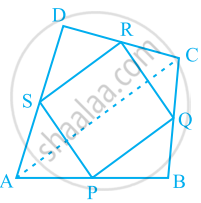Advertisements
Advertisements
प्रश्न
In the given figure, points X, Y, Z are the midpoints of side AB, side BC and side AC of ΔABC respectively. AB = 5 cm, AC = 9 cm and BC = 11 cm. Find the length of XY, YZ, XZ.

उत्तर
AB = 5 cm, AC = 9 cm and BC = 11 cm …(Given)
In ∆ABC,
Points X and Y are the midpoints of sides AB and BC respectively. ...(Given)
∴ XY = `1/2` AC ...(From midpoint theorem)
∴ XY = `1/2xx 9`
∴ XY = 4.5 cm
In ∆ABC,
Points Y and Z are the midpoints of sides BC and AC respectively. ...(Given)
∴ YZ = `1/2` AB ...(From midpoint theorem)
∴ YZ = `1/2xx 5`
∴ YZ = 2.5 cm
In ∆ABC,
Points X and Z are the midpoints of lines AB and AC respectively. ...(Given)
∴ XZ = `1/2` BC ...(From midpoint theorem)
∴ XZ = `1/2xx 11`
∴ XZ = 5.5 cm
APPEARS IN
संबंधित प्रश्न
ABCD is a quadrilateral in which P, Q, R and S are mid-points of the sides AB, BC, CD and DA (see the given figure). AC is a diagonal. Show that:
- SR || AC and SR = `1/2AC`
- PQ = SR
- PQRS is a parallelogram.

In a ΔABC, E and F are the mid-points of AC and AB respectively. The altitude AP to BC
intersects FE at Q. Prove that AQ = QP.
Prove that the figure obtained by joining the mid-points of the adjacent sides of a rectangle is a rhombus.
D, E, and F are the mid-points of the sides AB, BC, and CA respectively of ΔABC. AE meets DF at O. P and Q are the mid-points of OB and OC respectively. Prove that DPQF is a parallelogram.
In triangle ABC; M is mid-point of AB, N is mid-point of AC and D is any point in base BC. Use the intercept Theorem to show that MN bisects AD.
In ΔABC, D, E, F are the midpoints of BC, CA and AB respectively. Find FE, if BC = 14 cm
In ΔABC, D, E, F are the midpoints of BC, CA and AB respectively. Find DE, if AB = 8 cm
In a parallelogram ABCD, E and F are the midpoints of the sides AB and CD respectively. The line segments AF and BF meet the line segments DE and CE at points G and H respectively Prove that: EGFH is a parallelogram.
In ΔABC, the medians BE and CD are produced to the points P and Q respectively such that BE = EP and CD = DQ. Prove that: Q A and P are collinear.
P, Q, R and S are respectively the mid-points of sides AB, BC, CD and DA of quadrilateral ABCD in which AC = BD and AC ⊥ BD. Prove that PQRS is a square.
